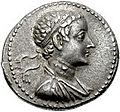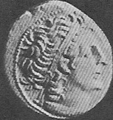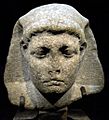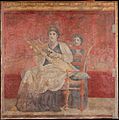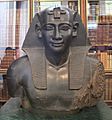Ptolemaic dynasty facts for kids
The Ptolemaic dynasty was a Greek royal family that ruled Egypt for nearly 300 years. Their rule lasted from 305 BC to 30 BC. They were the last family of kings and queens to rule ancient Egypt before the Romans took over.
Ptolemy, one of Alexander the Great's generals, was put in charge of Egypt after Alexander died in 323 BC. In 305 BC, Ptolemy declared himself King Ptolemy I. He was later called "Soter," which means "savior." The Egyptians quickly accepted the Ptolemies as the new pharaohs. Unlike some earlier rulers, the Ptolemies usually lived in Egypt. Ptolemy's family ruled Egypt until the Roman conquest in 30 BC.
All the male rulers in this family were named Ptolemy. The queens, who were sometimes also their husbands' sisters, were usually named Cleopatra, Arsinoe, or Berenice. The most famous queen was Cleopatra VII, the last ruler of the dynasty. She was involved in important Roman political struggles between Julius Caesar and Pompey, and later between Octavian and Mark Antony. Her death marked the end of the Ptolemaic rule in Egypt.
Contents
Who Were the Ptolemaic Rulers?
The dates next to each name show when they ruled. Many of them ruled with their wives, who were sometimes also their sisters. Some queens were very powerful, especially Cleopatra VII (51–30 BC). She ruled with her two brothers and later with her son.
- Ptolemy I Soter (305–282 BC) married Berenice I.
- Ptolemy II Philadelphus (282 BC–246 BC) married Arsinoe I, then Arsinoe II.
- Ptolemy III Euergetes (246–221 BC) married Berenice II.
- Ptolemy IV Philopator (221–203 BC) married Arsinoe III.
- Ptolemy V Epiphanes (203–181 BC) married Cleopatra I.
- Ptolemy VI Philometor (181–164 BC, 163–145 BC) married Cleopatra II.
- Ptolemy VIII Euergetes II (170–163 BC, 145–116 BC) married Cleopatra II and then Cleopatra III.
- Cleopatra II Philometora Soteira (131–127 BC) ruled against Ptolemy VIII for a time.
- Cleopatra III Philometor Soteira (116–101 BC) ruled with Ptolemy IX and Ptolemy X.
- Ptolemy IX Soter II (116–107 BC, 88–81 BC) married Cleopatra IV then Cleopatra Selene.
- Ptolemy X Alexander I (107–88 BC) married Cleopatra Selene then Berenice III.
- Berenice III Philopator (81–80 BC).
- Ptolemy XI Alexander II (80 BC) married Berenice III and ruled with her briefly.
- Ptolemy XII Neos Dionysos (80–58 BC, 55–51 BC) married Cleopatra V Tryphaena.
- Cleopatra V Tryphaena (58–57 BC) ruled with Berenice IV Epiphaneia (58–55 BC) and Cleopatra VI Tryphaena (58 BC).
- Cleopatra VII Philopator (51–30 BC) ruled with Ptolemy XIII Theos Philopator (51–47 BC), Ptolemy XIV (47–44 BC) and Ptolemy XV Caesarion (44–30 BC).
- Arsinoe IV (48–47 BC) was a rival to Cleopatra VII.
Other Important Ptolemaic Family Members
- Ptolemy Keraunos (died 279 BC) - The oldest son of Ptolemy I Soter. He later became king of Macedon.
- Ptolemy Apion (died 96 BC) - Son of Ptolemy VIII Physcon. He became king of Cyrenaica and later gave his kingdom to Rome.
- Ptolemy Philadelphus (born 36 BC) - Son of Mark Antony and Cleopatra VII.
- Ptolemy of Mauretania (died AD 40) - Son of Juba II and Cleopatra Selene II (who was the daughter of Cleopatra VII and Mark Antony). He was king of Mauretania.
Gallery of images
Images for kids
-
A painting of Cleopatra VII from Roman Herculaneum.
-
The Gonzaga Cameo showing Ptolemy II Philadelphus and Arsinoe II.
-
A cameo of Ptolemaic rulers.
-
A painting from a Roman villa, possibly showing Berenice II of Ptolemaic Egypt wearing a royal diadem.
See also
 In Spanish: Dinastía ptolemaica para niños
In Spanish: Dinastía ptolemaica para niños






